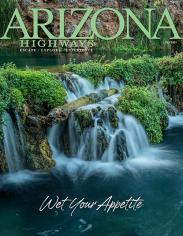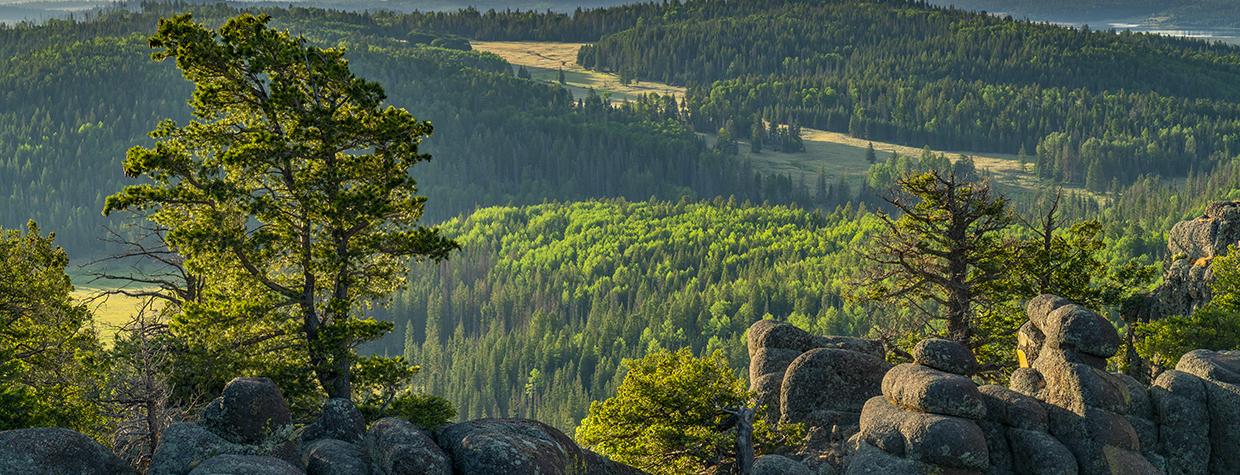Editor’s Note: This month, we continue the celebration of our centennial with another wonderful piece from our archive. Although we’re best known for our photography, we’ve also featured some exceptional writers over the past 100 years, including Jo Baeza. Nearly 50 years ago, she offered a glimpse at one of her favorite places. “Baldy is a living mountain,” she wrote, “accessible, vulnerable, open to all. Aging slowly in the eons, she draws energy from the sun, rain and lightning from the clouds. She gives life and takes life.”
Outstretched before us lay the tributaries of seven principal streams ... four main mountain peaks … valley lands far surpassing any I have before seen. The view of the landscape to the east is the most marvelous beauty of form and color. Mountain, forest, valley and streams are blended in one harmonious whole. ... Few world-wide travelers in a lifetime could be treated to a more perfect landscape, a true virgin solitude, undefiled by the presence of man.
That was the way Captain George M. Wheeler, U.S. Army, described Mount Baldy, crowning the White Mountains in Eastern Arizona, on a warm summer day in 1873. Except for the arrival of man, little has changed here in this high-country paradise.
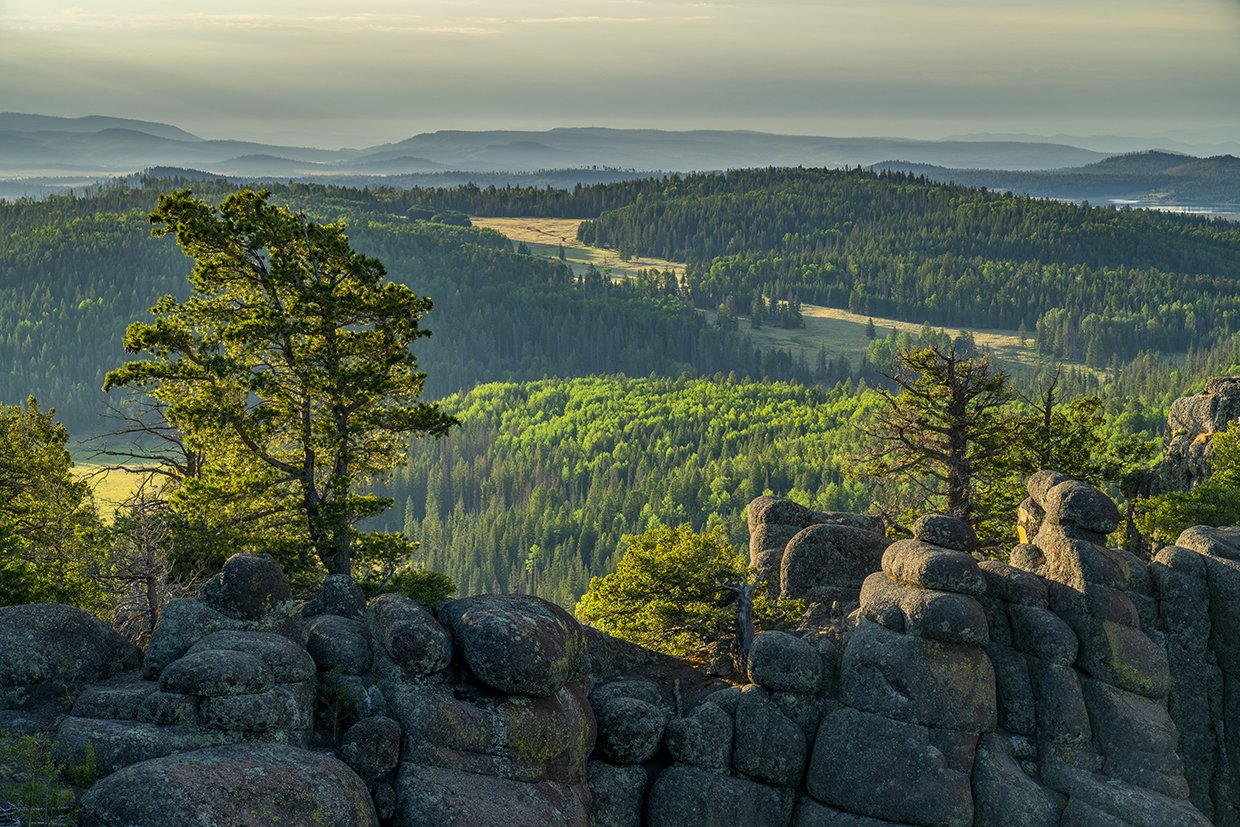
Now, as then, the forest is open and park-like, with stands of Engelmann and blue spruce; corkbark, white and Douglas-fir; Mexican white and ponderosa pine. Deer and elk pasture on wet meadows surrounded by shimmering groves of aspen.
But to the people here whose daily lives are intimately entwined with the mountain, Baldy is something much more than trees, grass and rocks. To them it has a special significance, a unique quality no one else shares.
To the White Mountain Apaches, Mount Baldy is Dzil Ligai, “White Mountain,” one of four sacred peaks venerated in the Southwest. It is the source of life, sacred in songs and prayers, home of the wind, and of Ga’an, the mountain spirits.
If any one tribe may be said to have a claim to the sacred mountain, it would be the White Mountain Apaches. Three-quarters of Mount Baldy, including the summit, are on the Fort Apache Reservation.
Edgar Perry’s office in the Apache Culture Center at Fort Apache overlooks the White Mountain. Young and ambitious, the scholar-historian is recording the history and legends of the tribe. “All Apaches who pray include the White Mountain in their prayers,” he says. “Especially when our people are away from their homeland, they pray for the people back home and for the mountain. When medicine men pray, they face the mountain. …
“My grandfather told me that in the old days, people made long journeys on foot up to the top of the mountain to worship. On their way, they gathered stones and piled them in little altars at the top of the mountain, to signify that it was a holy place.
“There is a cave near the summit,” he adds. “People say it is the home of the wind.”
Mary Riley, a beautiful old lady with long white hair, wears a flowing camp dress, sits in her garden in the sun, leaning on a walking stick. She has served her people for many years on the Tribal Council. But long before that, she spent childhood summers at the family ranch near Baldy. “There are no ruins on White Mountain,” she says. “No one ever lived there. The people who lived in this country before the Apaches worshipped on White Mountain for centuries. They would camp below the summit, then come to the top to pray. They left sacrifices of beads, turquoise, white shell, coral and black. The top of the mountain used to be covered with tiny beads, arrowheads and pottery with food offerings. But most of the pots and beads have been stolen or destroyed.
“We mention White Mountain in all our prayers,” Mary says. “It has special power ... when we mention it, our prayers are answered. When you take a prayer feather to the medicine man, you include White Mountain in your prayer. There are many sacred songs about White Mountain, but only medicine men can sing them, no one else. The wind lives on White Mountain. All the winds on Earth originated there.”
In July 1976, about 90 Apache people, young and very old, camped below the summit of Dzil Ligai, then walked to the top the next morning. On the bleak and barren summit, overlooking their whole reservation, they offered prayers of thanksgiving to Usen, the creator, for the beautiful land he gave them ... for the forest, the water and animals.
Many Apaches fear that their White Mountain, being sacred, will be desecrated by one of two forces: timber interests on the Apache side, or campers and hikers on the national forest portion.
Phillip R. Stago Jr., young, intense and innovative manager of the White Mountain Recreation Enterprise, wants to preserve the mountain as a wilderness area, and has fought a losing battle with timber people who want to log the south slopes. “Lumber is the biggest source of income for the tribe,” he says. “People are more interested in making money than they are in preserving our heritage.
“The difference between me and some of the other people down here,” he says, “is that I’ve been around. I’ve seen most of the national forests and parks, and I’ve been abroad. In all my travels, I’ve never seen anything as beautiful as my own reservation. I know what we’ve got here.” Since he cannot prevent logging, Stago hopes to control the disposal of logging debris and see that the logging roads with access to Baldy are closed.
Fishing is no longer permitted on Baldy, to protect the native trout that spawn in the headwaters of the many drainages. Hunting is allowed in the Baldy wilderness area, but tribal members are strictly regulated as to season, bag limits and type of firearm.
Game depletion was serious on the reservation when Stago took over as recreation manager. To stop the slaughter of elk on one of the world’s great hunting grounds, Stago initiated the reservation’s trophy elk hunt. Hunters are provided with Apache guides and guaranteed an elk. Only the old bulls, who will soon die, are taken.
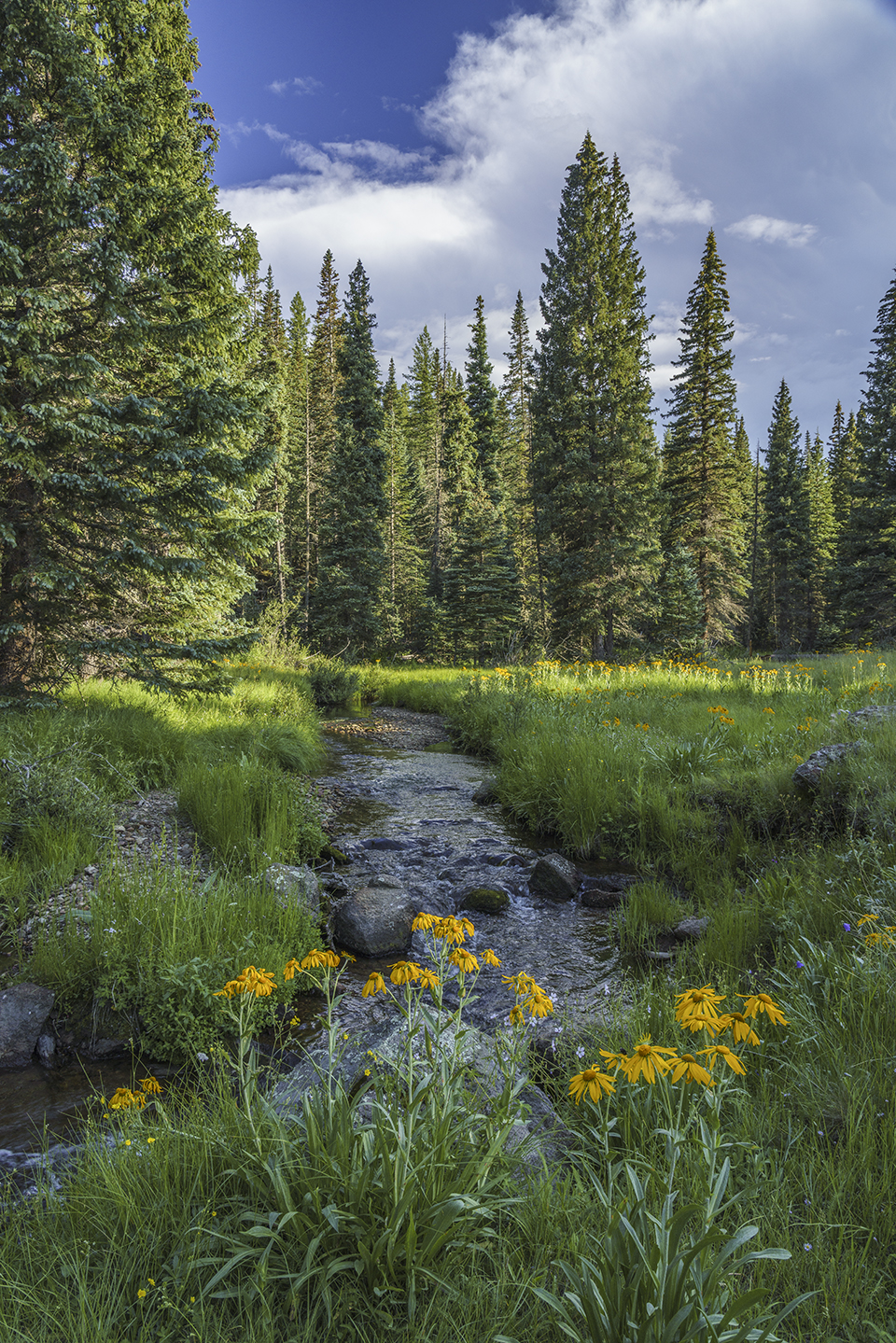
At first, the Tribal Council was against the idea. “Nobody would pay $750 to kill an elk,” they told Stago three years ago. In those days, the tribe sold 500 to 600 elk permits annually, with an 80 percent kill. This fall, 20 permits will be sold at $2,000 each. As a consequence, the elk herds will increase, damage to the wilderness will be kept at a minimum, and the tribe will still derive income from permits — because the trophy elk hunt is booked ahead for two years.
Camping will no longer be allowed on Baldy, either; day hikers and backpackers are welcome, but they will need a reservation permit.
To Stago, the new regulations are an attempt to control the flood of people on the reservation, to eliminate the need for search-and-rescue missions, to prevent man-caused fire, to stop the poaching of game and illegal firewood cutting.
“Our rules are not designed to cut people down,” Stago says. “They’re designed to protect our natural resources. Even if the rest of the world is polluted and overcrowded, I’m determined that this one place on Earth will remain unspoiled.”
On the other side of the boundary is U.S. Forest Service land, a quarter of which belongs in the Springerville Ranger District of the Apache-Sitgreaves National Forests. The Forest Service feels Baldy is in need of protection. They reiterate the concern of the Apaches for the mountain. Logging is not allowed in the Baldy Wilderness, but hunting, fishing, camping and grazing are. Baldy has only two cattle permittees: Vince Butler, whose family has lived in the area since the earliest settlement, and Harold Le Sueur.
Mount Baldy was among the first wild areas in the United States to be protected. In 1932, it was designated a primitive area. Then, in 1970, 6,975 acres on the northeast slope of Baldy were set aside as a wilderness area.
The Forest Service maintains two developed camping areas near the foot of Baldy: Winn and Big Lake campgrounds. Gabaldon Campground, near Phelps Cabin, is a primitive camping area.
For hikers, two main trails lead to the top of Baldy. Beginning at Greer, one follows the West Fork of the Little Colorado River; the other, the East Fork. Each is about 7 miles in length. And now much thought is being given to snowshoeing and cross-country skiing, interest in which is increasing.
Since the greatest damage to the environment is done by large groups, the Forest Service has had to limit camping groups to five people or members of an immediate family. Hiking and riding day groups also are limited to fewer than 25 members, and no more than 50 people may use the Baldy Wilderness at one time.
Beneath the clear headwaters of the Little Colorado, in a broad, willowed valley, is the small Mormon settlement of Greer, first known as Lee Valley. Named after the pioneer Americus Vespucius Greer, the community lies at the 8,560-foot level, in the lap of the mountain. The early settlers called it Mount Thomas. To them, the mountain meant lumber and shingles for their cabins; game for their tables; wild berries and honey; water for their fields and gardens; and the mountain meadows a pharmacy of medicinal herbs, roots and bark.
Greer was a close community. Of necessity, families helped each other. Their only source of income was from the grain they sold to Becker Mercantile in Springerville. Becker contracted with the government to sell oats to the cavalry at Fort Apache, and hired wagoners to haul it across the trail that is now State Route 273. When occasional bands of Apaches would harass the settlers, they would move to the fort in Round Valley for protection.
In summer, children of the settlers made excursions to the top of the mountain, fishing, hunting, berrying, exploring every canyon and stream. Boys ran horse races from the top to see who could find the fastest way down. Baldy was their world. They knew no other.
No one came to know the mountain better than George Crosby, who was born in 1900. His father had been sent from Silver Reef, Utah, to engineer the three Greer reservoirs and the irrigation canal to Round Valley. Burning with patriotic zeal but too young to enlist in the Army, Crosby, the only Boy Scout in the White Mountains, applied for the job of Forest Service lookout in the spring of 1917. His mother protested that the work was too lonely and dangerous, but George convinced her it was the only way he could serve his country.
Since most Forest Service personnel were fighting in the trenches of France, George was hired. On May 28, Forest Supervisor Frederic Winn rode his big black horse from Springerville to Greer to accept George’s application, give him instructions and tell him his salary would be $90 a month.
George had two days to get an outfit together and comfort his mother. He made a sleeping bag out of quilts and a heavy tarp. His Uncle Cleveland lent him a .30-30 Winchester. On the last day of May, he and his stepfather took two stout packhorses up to the trail to Baldy.
On the way, they found a dead buck and the enormous tracks of old Double-Killer, a grizzly bear with a habit of killing two beeves at a time. The huge bear had caused so much damage to livestock, the Cattlemen’s Association was offering a reward of $200 for his demise.
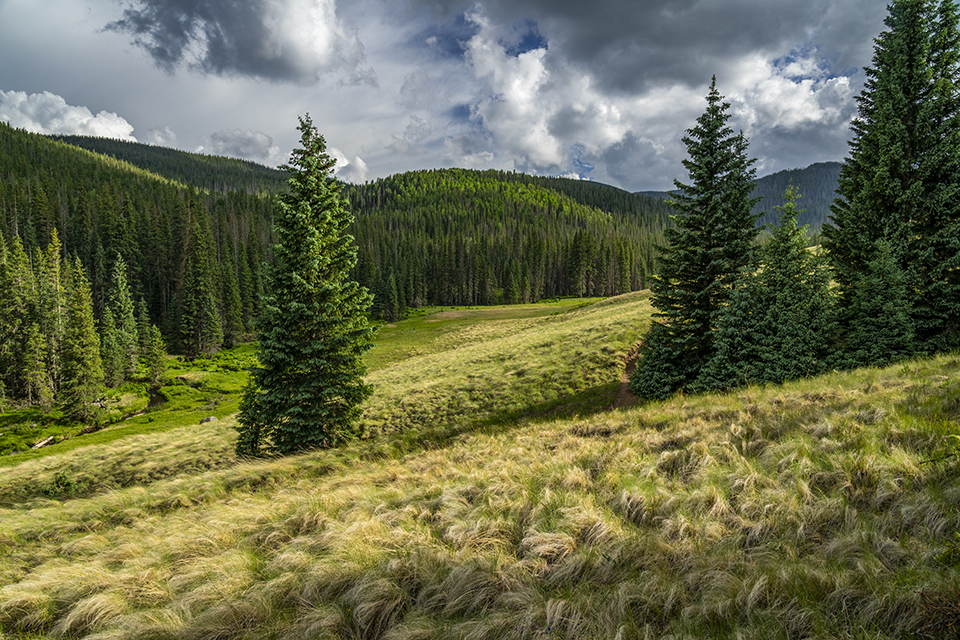
That night, George was alone in his 10-by-12-foot log cabin. His furniture consisted of a rat-proof chest, a pole bunk, a wood stove and a wall telephone. In those days, the Forest Service maintained a telephone line connecting Springerville with all the lookout towers and fire patrol stations. Each May, the Forest Service would send a pack train to pull the old wires out of the snow, rewire the line and install insulators. It was the lookout’s only communication with the outside world for three months.
The lookout station on the summit was an eight-sided affair with a central chart stand, a small stove and a chair. When he spotted a fire, George would ring up the supervisor and tell him the degree and general location of the fire. From his perch, George could see north to the Hopi mesas; east to Zuni Pueblo and the Mogollon Mountains; south a hundred miles to the Graham Mountains; and west all the way to the Sierra Ancha.
After work hours, he chinked the walls of his cabin with mud, because, he said, “you could sling a cat out through the logs.” He cut and stacked firewood, cooked his simple meals, hauled water from a spring and, for amusement, listened in on the telephone conversations between Forest Service men and their mountain sweethearts. During his lunch breaks, he would hunt for arrowheads and beads.
His sister Hannah rode up from Greer to bring supplies and to keep him company for a while. They were surprised one night by a knock at the cabin door. A young Hopi, a graduate of the Carlisle Indian Industrial School, introduced himself and explained that he had come with four old men of the Flute Clan to pray for rain. They asked the young people to keep their presence a secret. Camped by the spring, with no articles of the white man on them, they performed their rituals and sang. The young Crosbys attended their final rain ceremony, and later watched Northern Arizona drown in a general downpour.
As the year wound down, George and his Hopi friend shot old Double-Killer, who was prowling around their camp one night. The boys scraped and dried the hide, collected the $200 reward and sold the skin at the Grand Canyon for $450.
At 17, George Crosby’s adventures were only beginning. The next summer he worked as a fireguard on Greens Peak while Hannah took on the station at Baldy, becoming America’s first girl lookout. The following year, George drove 21 saddle horses to Phoenix on his way to Thatcher to attend Gila Academy. But his real education came from the mountains.
Over the years, George Crosby was to become well known as a hunter and guide, at one point leading the U.S. Geological Survey parties and setting up their camps.
Before World War II, George hiked through a blizzard to locate a missing plane on Baldy. Drifts were 20 feet high, but he made it to Colter Cabin, where he spent the night. The following day, the main party met him. They found the plane, with eight bodies aboard, and carried them down the mountain, along with a suitcase containing $20,000.
In later years, while running an elk camp on Baldy, George and his sons fed the deer grain and hay, along with their own stock, during hard winters and watched for poachers and other game violators.
Today, George Crosby’s son Harris operates a general store in Greer, which remains a small mountain settlement drowsing under the wing of Baldy. Fat horses and cattle graze in fields of hay. The scent of pine, spruce and fir overlies the valley, and the pure, cold smell of water tumbling out of snowfields rises to meet it. A few resorts, a few modest summer cabins, neighbor the old log cabins of the settlers. The road to Greer goes nowhere. There are only trails, leading to the mountain.
Baldy is a living mountain ... accessible, vulnerable, open to all. Aging slowly in the eons, she draws energy from the sun, rain and lightning from the clouds. She gives life and takes life. She is the mother mountain to all who live in her shadow, a holy place ... forever.
